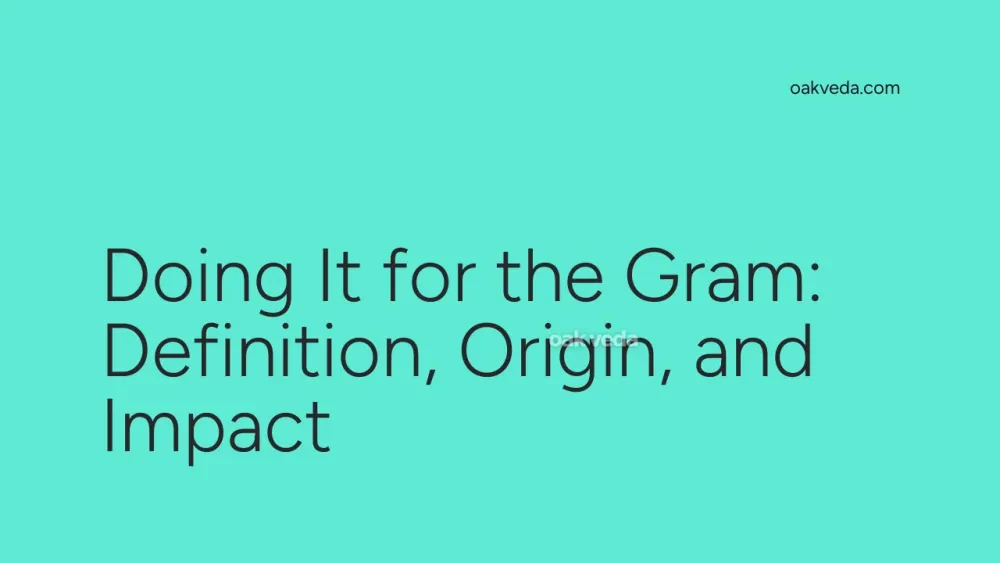
What is "Doing It for the Gram"?
"Doing it for the gram" is a popular phrase in social media culture that refers to the act of engaging in activities, visiting places, or creating content primarily for the purpose of sharing it on Instagram (or other social media platforms). This behavior prioritizes the appearance or perception of an experience over the actual enjoyment or authenticity of the moment.
Origin and Development of "Doing It for the Gram"
The phrase originated in the early 2010s as Instagram gained popularity. "The gram" is a colloquial term for Instagram, and the expression quickly became a part of internet slang. As social media's influence grew, so did the prevalence of this behavior and the use of the phrase to describe it.
How "Doing It for the Gram" Works
This phenomenon typically involves:
- Choosing activities or destinations based on their photogenic qualities
- Staging or posing for photos to create a specific image or narrative
- Editing and filtering images to enhance their visual appeal
- Sharing these curated moments on social media platforms
- Seeking validation through likes, comments, and followers
Types or Variations of "Doing It for the Gram"
While the phrase originally referred to Instagram, it has expanded to encompass various social media platforms and behaviors:
- "Doing it for the 'Tok" (TikTok)
- "Doing it for the 'Tube" (YouTube)
- "Doing it for the snap" (Snapchat)
Popular Examples of "Doing It for the Gram"
Some common instances include:
- Visiting trendy restaurants solely to photograph aesthetically pleasing dishes
- Traveling to popular tourist destinations for iconic photo opportunities
- Attending events or exhibitions primarily to create shareable content
- Purchasing products or fashion items specifically for social media posts
Impact of "Doing It for the Gram" on Social Media Culture
This phenomenon has significantly influenced social media culture:
- Content creation: Users are increasingly focused on producing visually appealing and shareable content.
- Travel trends: Certain locations have seen a surge in popularity due to their "Instagrammability."
- Consumer behavior: Purchasing decisions are often influenced by an item's potential for social media content.
- Mental health: The pressure to maintain a perfect online image can lead to anxiety and self-esteem issues.
- Authenticity debates: Questions arise about the genuineness of experiences shared on social media.
Controversies and Debates Surrounding "Doing It for the Gram"
The practice has sparked several controversies:
- Environmental impact: Increased tourism to photogenic locations can lead to environmental damage.
- Safety concerns: People sometimes engage in risky behavior to capture the perfect shot.
- Cultural insensitivity: Some travelers prioritize photos over respecting local customs and sacred sites.
- Misrepresentation: The curated nature of social media can create unrealistic expectations and FOMO (fear of missing out).
How Brands and Influencers Use "Doing It for the Gram"
Businesses and influencers have capitalized on this trend:
- Instagrammable spaces: Companies design photo-friendly environments to attract customers and encourage social sharing.
- Influencer marketing: Brands collaborate with influencers to create aspirational content that showcases their products.
- User-generated content: Businesses encourage customers to share photos with branded hashtags, creating a cycle of "doing it for the gram."
- Experience-based marketing: Events and pop-ups are designed with social media sharing in mind.
Future Trends Related to "Doing It for the Gram"
As social media evolves, so does this phenomenon:
- Authenticity movement: A counter-trend emphasizing genuine, unfiltered experiences is gaining traction.
- AR and VR integration: Advanced technologies may offer new ways to create and share experiences.
- Ephemeral content: Platforms like Instagram Stories and Snapchat encourage more spontaneous, less curated sharing.
- Ethical considerations: Increased awareness of the negative impacts may lead to more responsible social media practices.
FAQs about "Doing It for the Gram"
-
Is "doing it for the gram" always negative? Not necessarily. While it can lead to inauthentic experiences, it can also inspire creativity and encourage people to explore new places and activities.
-
How can I avoid falling into the "doing it for the gram" trap? Focus on enjoying experiences for their own sake, limit your social media use during activities, and be mindful of your motivations for sharing content.
-
Can businesses benefit from this trend without being inauthentic? Yes, by creating genuinely enjoyable experiences that also happen to be photogenic and encouraging honest, diverse representations of their brand.
-
How has the COVID-19 pandemic affected this phenomenon? The pandemic has shifted focus to home-based content and virtual experiences, but as restrictions ease, there's a resurgence of travel and event-based social media sharing.
-
Is "doing it for the gram" exclusive to younger generations? While it's more prevalent among younger users, people of all ages engage in this behavior to varying degrees.
In conclusion, "doing it for the gram" has become a significant aspect of modern digital culture. While it has transformed how we document and share our lives, it's essential to strike a balance between creating engaging content and maintaining authentic experiences. As social media continues to evolve, so too will the ways in which we interact with and create content for these platforms.
You may be interested in:
- BeReal: Definition, Origin, and Impact on Social Media
- Evergreen Content: Definition, Origin, and Impact
- Brand Partnership: Definition, Origin, and Impact
- Social Media Management: Definition, Origin, and Impact
- Lookalike Audience: Definition, Origin, and Impact
- Go Live: Definition, Origin, and Impact on Social Media

